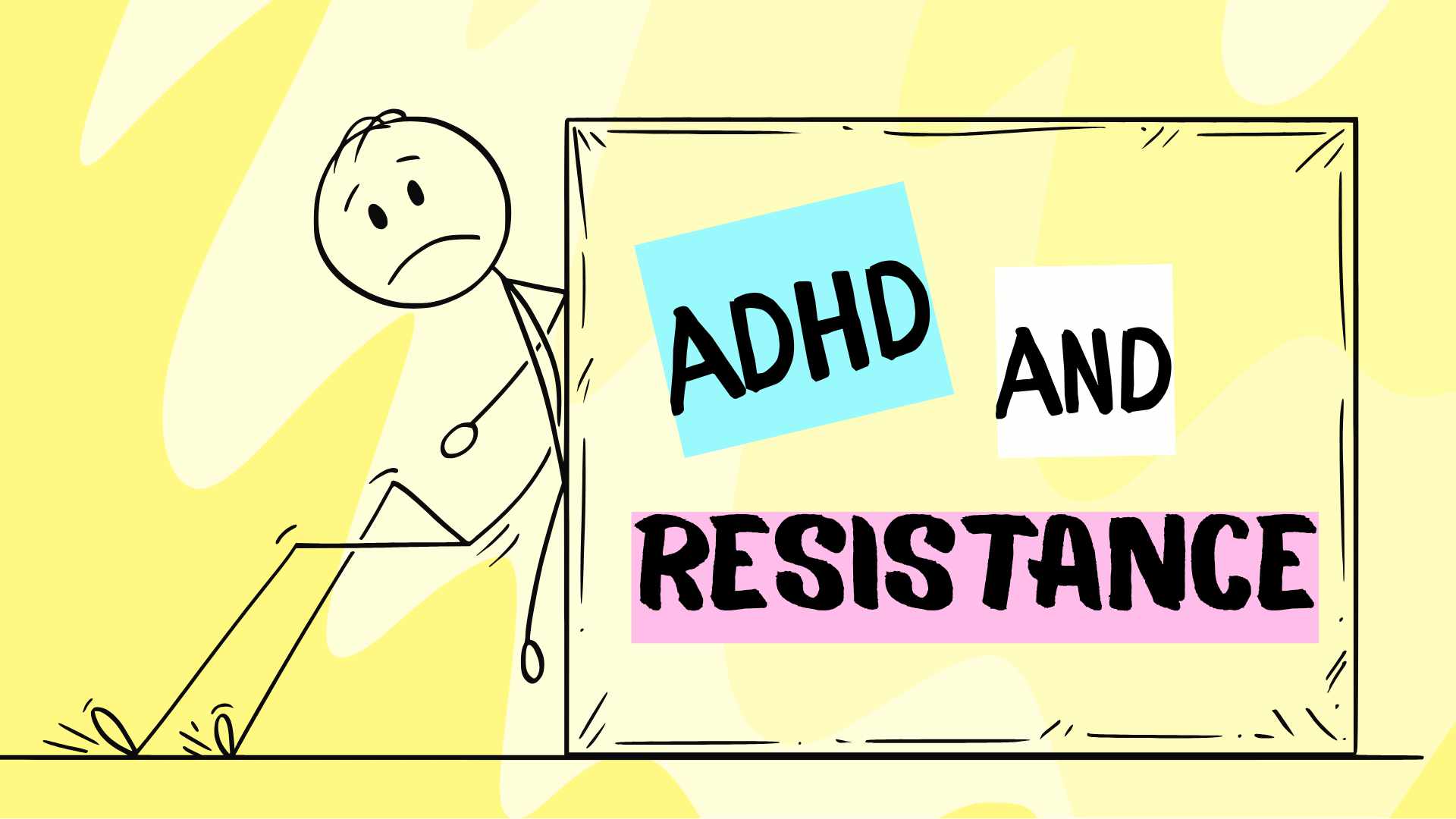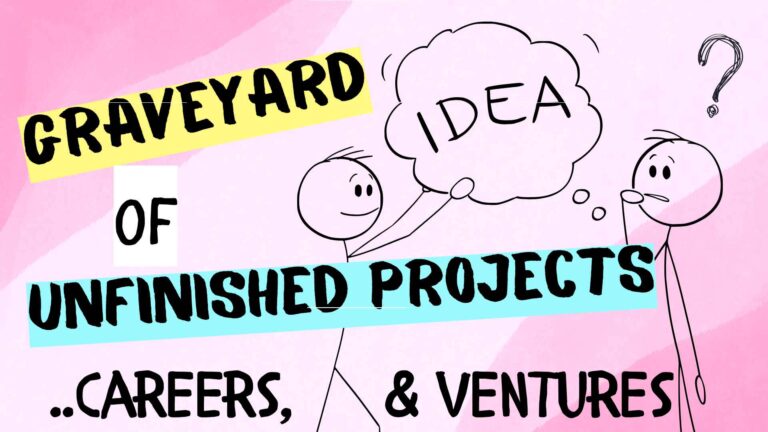Ever felt like you’re fighting against yourself? You know what you need to do, but there’s this invisible force stopping you from actually doing it. Welcome to the world of resistance and the ADHD brain—where motivation, executive function, and even emotions collide in frustrating, fascinating ways.
This is a twofer, folks (two for the price of one)! There are TWO type of resistance:
- resisting unpleasant tasks
- resisting getting started on your dream and goals
At the heart of both, is your resistant brain stopping you from getting done what you need to do. If you’re resisting daily tasks, or even worse, big dreams and goals – you need to learn why resistance is the culprit.
Table of Contents
- Why Resistance Happens
- Resistance Stops Dreams
- Case Study: Resisting Starting a YouTube Channel
- Final Thoughts
Why Resistance Happens
For many with ADHD, resistance isn’t laziness—it’s often a mix of:
- Executive Dysfunction: The brain struggles to organize, plan, and start tasks, even important ones.
- Emotional Overwhelm: When a task feels intimidating, boring, or complicated, the emotional response can create avoidance.
- Perceived Effort vs. Reward: If the payoff doesn’t feel immediate or “worth it,” it’s hard to push through.
- Task Paralysis: Too many options or steps can lead to shutdown mode.
There are a lot of factors at play that are holding you back. Barbara Sher offers this wisdom:
“You cannot just battle your way through resistance. It’s not about will power or determination or changing your perception or positive thinking. Resistance is a powerful survival instinct and to get past it, you have to know what you’re doing… But you can get past it and it’s a lot easier than you think.”
The battle between intention & action
ADHD brains often want to do the thing but get stuck before the first step. Imagine standing at the edge of a pool—you want to dive in, but your brain keeps screaming, “Hold up!” Instead of making a smooth leap, there’s a standoff between the part of your brain that understands the task’s importance and the part that wants to avoid discomfort.
Recently, I’ve pondered this in my own life. My biggest walls are checking email (to the point of email avoidance), putting off the business side/office time of my side hustle, and making financial decisions. I’m calling this the “necessary evils” of life.
Then there is the resistance of my deepest desires, my inability to move forward on my dreams, that makes me the saddest. The famous pioneer in hacking ADHD brains, Barbara Sher, identified this topic as a key reason people don’t follow through.
Megan Griffith on her Youtube channel The Neurocuriosity Club says that we deal with more mental pain when it comes to starting boring or difficult tasks. Because the pain is real, your desire to avoid it makes sense.
ADHD brains’ sense of time is not very linear: we see a task as “now” or “not now”. I feature more of Meagan’s advice and task avoidance checklist in my procrastination article.
Resistance Stops Dreams
Barbara Sher spoke extensively about resistance—the invisible force that stops people from pursuing what they truly want (her focus was on reaching dreams/goals not completing unpleasant tasks). She described resistance as a survival mechanism that kicks in whenever an action raises anxiety or feels risky. It goes back to that old caveman mentality, our brains stop us from potentially hurting ourselves.
Instead of blaming lack of motivation, she encouraged people to identify the source of their resistance and find strategies to work through it.
I cannot encourage you enough to read Barbara’s books. If you’re looking for a little cheerleader in your corner, Barbara is it. Every sentence is a drop of gold! She so deeply understood many aspects of the ADHD brain, including resistance.
People feel their life is passing them by
Here are Barbara’s thoughts on resistance, taken from the video below:
People have something inside of them that is not expressed, and it hurts, and it aches. They feel something is wrong, something is not happening, and it’s passing.
They blame themselves, take a deep breath, get all determined, and deciding they’re going to do it again… and then hating themselves again [when they don’t follow through].
My contribution to the world, is getting the rest of you to give your gifts to the rest of us… Everyone has at least one, real, spark of genious inside of them… My mission is to help the rest of you flourish.
Barbara’s strategies for overcoming resistance
Resistance isn’t unbeatable—here are some ways to work with your brain:
- Lower the Bar – Instead of aiming for perfection, start with the smallest possible step. Sher encouraged people to do the easiest version of a task first (even thinking about starting counts!).
- Trick Your Brain – Resistance often kicks in when a task feels overwhelming. She suggested breaking tasks into tiny, non-threatening pieces to bypass the brain’s alarm system.
- Use Accountability & Support – She created Success Teams, small groups where people helped each other stay motivated and push past resistance.
- Identify the Real Fear – Sher believed resistance often masked deeper fears (failure, judgment, change). She encouraged people to name their fears and address them directly.
- Make It Fun – Resistance thrives on dread. She advised turning tasks into games or adding enjoyable elements to make them feel less daunting. Turn work into a challenge, race, or point system can unlock motivation.
- Accept Resistance as Normal – Instead of fighting it, she encouraged people to acknowledge resistance as part of the process and work with it rather than against it. Remind yourself that ADHD resistance is real and normal.
- Body Doubling: Working alongside someone—virtually or in person—can help ease the friction.
Use the “Pause” & Self-Talk techniques
It recently dawned on me that I was putting up a hard wall on certain to-dos. Taking the simple action of pausing for a moment helped to disintegrate that barrier.
I’m big on self-talk, an effective strategy to re-focus my brain and steer it back on path. Self-talk is especially effective if you talk to yourself out loud. I find it adds one more person into the conversation, providing the voice of reason (and interrupting any ruminating thoughts that start to form).
Let’s use self-talk to encourage me to check my email:
“My email is not the villian I think it is. Checking my email will help me to prevent a big pile up later. I will feel great that I have it under control. I’ll just go in and take care of the first page.”
In addition, there are other helpful easy actions you can take to defeat resistance. For example, change your environment. A new location, music, or lighting can shift your brain into action mode.
Don’t forget self-compassion – it’s so important to be kind to yourself, you don’t have to be perfect! The pause it takes to tell yourself “I can do this!” can bust out any RSD (Rejection Sensitive Dysphoria) and negative self-talk going on.
Case Study: Resisting Starting a YouTube Channel
I thought I would throw in a real-life example of resistance. Barbara Sher suggests identifying the source of your resistance and then find strategies to work through it.
I’m using the example of starting a YouTube channel. I vascillated for a long time to do it or not. Authoring this website is deeply satisfying, but I knew it wouldn’t move the bar towards personal success unless I carried it over to Youtube.
For me, resistant factors included fear of judgment, perfection, decision making, and time/content constraints.
This isn’t my first rodeo. I’m familiar with the technical aspects and equipment, far more than the beginner YouTuber. It’s the mindset and perfection that hung me up.
Solution: The videos are based on my website articles (which I love to do), so I’ve removed the overthinking (and the analysis paralysis of decision making). I’ve streamlined/simplified thumbnails and featured image creation, speeding up that bottle neck (my perfection hang up). I’ve made a solid choice not to overproduce my videos and try to record in one shot, which greatly reduces post-production time.
Finally, I took a deep breath and decided to do a 30-day push out (and see what happens after that). There easily was enough content from my website to keep going. Living with the regret of not giving it a shot would haunt me if I didn’t follow through.
Downfalls: Admittedly, I quit when I don’t see progress. Don’t get me wrong, there’s a right time to quit. However, our ADHD minds are interest-based. If we don’t see results to motivate us and hold that interest, we quit sooner than most.
I’ve started and stopped a few YouTube channels. With that failed experience and new knowledge, I think have the approach right this time to work.
The words from Barbara Sher rings in my mind:
People have something inside of them that is not expressed, and it hurts, and it aches. They feel something is wrong, something is not happening, and it’s passing.
My biggest goal in life is to see personal success. It frustrates me to have all of these talents in my personal roster and not see this goal met. I badly want to overcome the resistance that is holding me back.
What steps would you take in your situation to overcome resistance?
Final Thoughts
Breaking through resistance isn’t about forcing yourself to “just do it.” Instead, it’s about understanding your brain’s patterns and finding ways to work with them, not against them. Small wins build momentum—and even tiny progress counts.
Whether it’s small tasks, or you have a burning desire to do something big, getting past resistance can help see those projects through to the end.
#inthistogether -Renee




